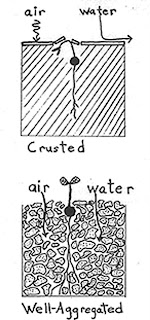There seem to be a lot of misconceptions about soil, what makes good soil, and why urban soil is so different than rural soil. First, it’s important to understand the components of soil and how healthy soil differs from soil in the built environment. Second, we need to know what an impervious surface is and how it differs from pervious surfaces. Third, we can now make the connections to urban environments and the importance of public transportation.
Healthy Soil
What does healthy soil look like? Healthy soil is full of microbial action and drainage. Healthy soil has bugs and worms that tunnel through allowing plants to breath underground and giving water a place to go. Healthy soil with healthy vegetation soaks up water from rain or other water events and draws it down first into their root systems and then further filters water down to the water table, eventually replenishing ground water supplies.
Impervious Surfaces and Why They Are Bad
Impervious surfaces prevent water from adequately soaking into the ground. Impervious surfaces can be compacted soil (urban soil), pavement, asphalt, housing with standard roofs, or even grass. Anything that prevents water from properly filtering into the soil to nourish plants and animals that live below the ground is an impervious surface.
“A raindrop is like a miniature water bomb: it hits the ground at 20 miles per hour. When raindrops hit bare soil, water can splash soil up to 6 feet away, carry particles away, and drop sediment into drainageways. Wind also dislodges, moves, and transports soil particles. We need that topsoil; it nourishes our food and allows us to live, but it can take almost 1,000 years to be created (Oregon Association of Conservation Districts 2007). In Portland specifically, composted soil can be made in a week (Plantea 1998).” [As quoted in The Tolman Guide to Green Living in Portland, first page Soil Section.]
Additionally, living in places with a lot of impervious surfaces makes that place more vulnerable to floods. When watersheds are prevented from doing their job, managing water naturally, floods are a bigger risk. The water from water events still needs to find someplace to go, and with impervious surfaces that place is usually a parking lot, which leads to the street and sidewalk, or even your basement.
Linking It Back to Place
I live in an urban environment, so it’s important for me to be aware of how my actions affect the environment around me. Likewise, when we learn how we can live in our urban environment full of compacted soil and impervious surfaces, we have more knowledge to make better choices. If, for example, we rely on public transit more than our personal cars, we lessen demand on the roads. Each bus here in Portland helps keep about 256 cars off the road. Imagine 1 bus for every 250 cars and think of how much less air pollution and ground pollution we would have if we improved that ratio. Now, consider what would happen when we plant with native plants in our yards, we use natural methods to help water go where it needs to go – in the ground, further reducing risk of flood and improving the environment in which we live.
I hope this basic run-through of why healthy soil is important helps with our general understanding of how place has a direct affect on our local ecology. Please email me with questions, further reading, or any thing else!





I am unclear how the quote about rain splash erosion is relevant to impervious surfaces…through one set of lenses, impervious surfaces could prevent rain splash erosion. For example, trees and grasses prevent rain splash erosion and top soil loss.
Thanks Beth for always keeping me in check and on my toes.
I've been consistently briefed to treat grass as an impervious surface without good explanations as too why. The best thing I can do now is to think about how it works when watering my plants. The mulched areas absorb water nicely, whereas grass allows the water to pool much like hard-caked mud or concrete.
Impervious surfaces like concrete especially do not prevent erosion, they enhance it by not allowing the water to properly filter like trees do, holding the water in place and strengthening root systems.
For a better answer, we both have to wait for the 2 books I just put on hold from Multnomah County & PSU.
I like the idea of “fertile soil” as opposed to “healthy soil”. I think that by saying “healthy soil” we are anthropomorphizing an Earth substrate. However, soils can be fertile or not fertile.